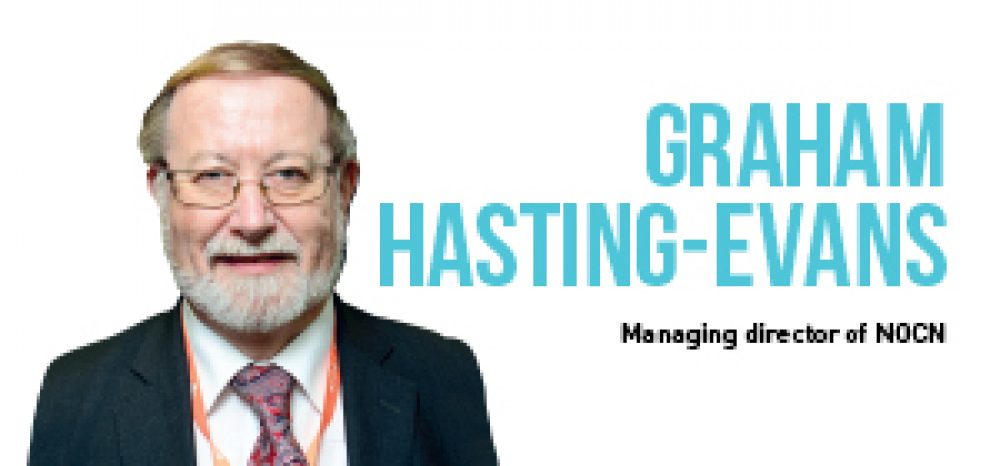The old adage when you’re in a hole first stop digging before you find a way out couldn’t be more true so far as apprenticeship reform is concerned – at least that’s the view of Graham Hasting-Evans.
Following the publication of the Enterprise Bill at the end of February, I believe the Institute for Apprenticeships (IfA) might just be the way to rekindle enthusiasm for Trailblazers – solving the issues and anxieties surrounding apprenticeships. Let me explain…
The government started reforming apprenticeships more than three years ago but the blunt truth is, thus far, insufficient progress has been made.
Its aim is to improve the quality of apprenticeships with fundamental reforms so that skills and productivity within the economy will increase.
But while some excellent work has been carried out by the Employer Groups – working together to design world-class apprenticeship standards and assessment approaches – we need to consider the actual rate of progress.
Currently there are 1,700 job roles in the existing apprenticeship frameworks – excluding degree apprenticeships and sectors which do not traditionally have apprentices.
The best estimate of the total number of reformed apprenticeship standards which are going to be needed across the economy, based upon the government’s current approach, is likely to be 2,000 to 2,500.
But although Trailblazers have been around since October 2013, (when they were formally announced) the present rate to complete to the Skills Funding Agency (SFA) ‘ready for delivery’ status is just 38 per year – that means it could take several decades to complete all the reformed apprenticeship standards and assessment plans.
Little wonder then people engaged in the Trailblazer process say not enough progress is being made
Little wonder then people engaged in the Trailblazer process say not enough progress is being made.
To increase the number of standards and assessment plans ready for delivery the present Trailblazer process will need to be reformed with a robust operational system put in place, led by employers.
It seems SASE (Specification of Apprenticeship Standards for England) apprenticeships are going to be around for some time, bridging the gap.
So what are the major risks facing the apprenticeship reform programme in achieving 3m ‘high quality’ apprenticeships? Well, personally I think they include:
A lack of a detailed and coherent design for the ‘new world’ of reformed apprenticeships, underpinned by a detailed implementation programme;
Also insufficient progress. Some Trailblazers have been two years in development and are still not complete;
The scale of the increased and complex administrative burden also appears to be designed into the new arrangements by government.
It could see employers, particularly SMEs, deciding not to engage with Trailblazer apprenticeships or apprenticeships at all. On some Trailblazer groups employers are already drifting away saying ‘it’s in the too hard box’.
Also of concern is the potential reduction in the numbers of adults undertaking apprenticeships – 40 per cent of apprenticeships over the last five years have been over 25.
Then there are inconsistencies in approach between various standards and their assessment plans – as well as apparent duplications and overlaps in the standards being developed by different industry groups.
Also, the omission from the design of a ‘Skills and Training Plan’ which sets out clearly how skills will be developed in the work-place, the role of work-place learning, mentoring and the type of formal training
The governance structures, in the form of the IfA and the Digital Apprenticeship Service (DAS), have only recently been tabled. It will be a considerable challenge to get these fully operational.
Inefficient clarity or transparency on the full extent of the roles for these new governance organisations and inadequate communication to the organisations key to a successful implementation of the reforms, i.e. the several hundred thousand employers, including SMEs, training providers and AAOs/AOs is another issue.
So what needs to be done? The 10 point plan below might be the answer. I think we should:
Complete the detailed design of the new apprenticeship reforms and system – including creating a firm understanding of how many apprenticeship standards are both required and desirable across the economy;
Finalise and publish the details of a streamlined business process which can be used by SMEs and others as well as the details of the new DAS portal;
Establish a realistic and robust implementation plan, with all the support risks, issues and governance structures;
Complete the detailed design of the functions and structure for the IfA and make these public – this should ensure there is proper provision for the potential additional functions of the IfA;
Resource the IfA. This would not only increase the production of apprenticeship standards and assessment plans but also ensure it can discharge all of its functions;
Unfreeze the existing SASE apprenticeships allowing a staged transition to the new arrangement;
Use industry sub-committees in IfA to establish a definite list of apprenticeship standards needed in each sector and undertake an analysis of cross-sector roles to cut duplications. In doing this the sub-committees should consider the core skills for broad apprenticeships as an entry to sectors as well as a pathways approach to developing specialism. By doing this we believe the number of apprenticeship standards eventually required could be reduced to a more manageable number;
Compare the definite list with the SASE list and so identify which standards could be produced by a ‘fast-track’ upgrade of existing apprenticeships;
Prioritise development of reformed apprenticeship standards based upon potential apprenticeship numbers and relative ease of ‘fast-tracking’;
And finally stablish and implement a communication plan for possible apprenticeships, parent, schools, career advisers, employers, training providers, AAOs/AOs and other stakeholders
When you are in a hole the first thing to do is stop digging before you find a way out. I think the formation of an IfA could be used as the mechanism for implementing the actions now needed.
Graham Hasting-Evans is managing director of NOCN








Your thoughts